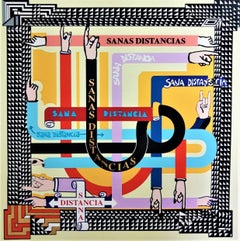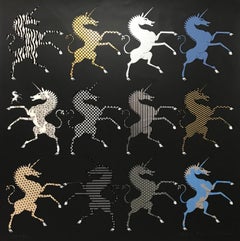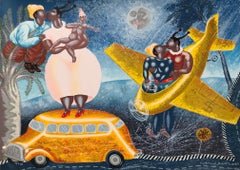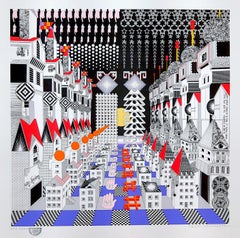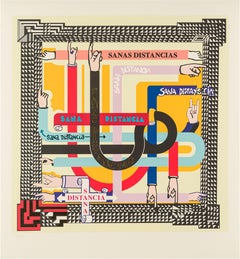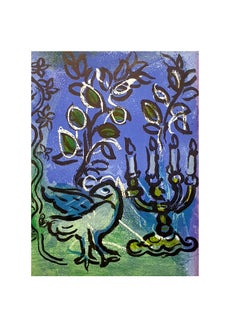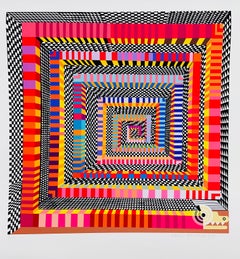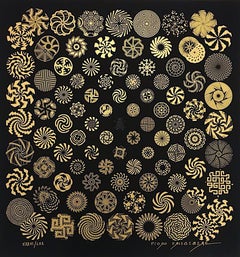Cotton Figurative Prints
to
2
5
1
Overall Width
to
Overall Height
to
8
8
4
4
2
1
7
1
2
6
5
2
1
4
3
3
3
2
2
2
1
1
1
1
1
1
1
1
1
1
1
1
1
23,422
1,136
822
361
180
3
3
1
Style: Surrealist
Medium: Cotton
"Sanas distancias" Safe distances - figurative, hands, post COVID art
Located in Ciudad de México, MX
During the pandemic, the artist stayed for 4 months in Oaxaca on a beach called San Aguistinillo, where he developed the Sana Distancia (safe distance) c...
Category
21st Century and Contemporary Surrealist Cotton Figurative Prints
Materials
Gold Leaf
"Cromaticornios II" - surrealist pattern, unicorns, gold leaf, silver leaf
Located in Ciudad de México, MX
Pedro Friedeberg is an artist and designer from Mexico of Italian origin, known for his surreal work full of lines, colors, and ancient religious symbols. His best-known piece is the...
Category
21st Century and Contemporary Surrealist Cotton Figurative Prints
Materials
Gold Leaf, Silver
Maximino Javier Mexican artist original hand signed silkscreen surrealism
Located in Miami, FL
Maximino Javier (Mexico, 1948)
'Bajada de emergencia (serie Tamayo Total)', 2023
silkscreen on paper Canson 320 g.
20.3 x 28.2 in. (51.5 x 71.5 cm.)
Edition of 100
Unframed
ID: JAV-1...
Category
2010s Surrealist Cotton Figurative Prints
Materials
Cotton, Paper, Screen
"Cíclopes" Cyclops - surrealist geometric print, perspective, optic illusion
Located in Ciudad de México, MX
Pedro Friedeberg is an artist and designer from Mexico of Italian origin, known for his surreal work full of lines, colors, and ancient religious symbols. His best-known piece is the “ManoChair”: a sculpture/chair designed to sit on the palm, using the fingers as backrests and armrests. Friedeberg began to study architecture but did not finish his studies. He began to produce designs that went against the conventional forms of the 1950s, some as incredible as houses with artichoke roofs. His work caught the attention of Mathías Goeritz who encouraged him to continue his career as an artist. Friedeberg became part of a group of Mexican surrealist...
Category
21st Century and Contemporary Surrealist Cotton Figurative Prints
Materials
Gold Leaf
"La nariz de Cleopatra" Cleopatra's nose - geometric, perspective, city
Located in Ciudad de México, MX
Pedro Friedeberg is an artist and designer from Mexico of Italian origin, known for his surreal work full of lines, colors, and ancient religious symbols. His best-known piece is the...
Category
20th Century Surrealist Cotton Figurative Prints
Materials
Paper, Screen, Cotton
"Sanas distancias" Safe distances - figurative, hands, post COVID art
Located in Ciudad de México, MX
During the pandemic, the artist stayed for 4 months in Oaxaca on a beach called San Aguistinillo, where he developed the Sana Distancia (safe distance) collection, he created each da...
Category
21st Century and Contemporary Surrealist Cotton Figurative Prints
Materials
Gold Leaf
"Triperio lunar I" Lunar triperium, geometric, cube perspective, black and white
Located in Ciudad de México, MX
Pedro Friedeberg is an artist and designer from Mexico of Italian origin, known for his surreal work full of lines, colors, and ancient religious symbols. His best-known piece is the...
Category
21st Century and Contemporary Surrealist Cotton Figurative Prints
Materials
Cotton, Paper, Screen
City of a million with 25 boiled eggs
Located in Ciudad de México, MX
Pedro Friedeberg is an artist and designer from Mexico of Italian origin, known for his surreal work full of lines, colors, and ancient religious symbols. His best-known piece is the...
Category
20th Century Surrealist Cotton Figurative Prints
Materials
Paper, Cotton, Digital
Related Items
Cathedral of Christ the Savior. 1989., paper, screen print, 60x32.5 cm
Located in Riga, LV
Cathedral of Christ the Savior. 1989, paper, screen print, 60x32.5 cm
Category
1980s Surrealist Cotton Figurative Prints
Materials
Paper, Screen
$851 Sale Price
20% Off
H 23.63 in W 12.6 in D 0.04 in
Marc Chagall - The Candlestick - Original Lithograph
By Marc Chagall
Located in Collonge Bellerive, Geneve, CH
The Candlestick, from Jean Leymarie, Vitraux pour Jérusalem (Jerusalem Windows), André Sauret, Monte Carlo, 1962 (see M. 366-72; see C. books ...
Category
1960s Surrealist Cotton Figurative Prints
Materials
Lithograph
$2,493
H 12.8 in W 9.65 in D 0.04 in
Marc Chagall - Inspiration - Original Lithograph from "Chagall Lithographe" v. 2
By Marc Chagall
Located in Collonge Bellerive, Geneve, CH
Marc Chagall
Original Lithograph from Chagall Lithographe 1957-1962. VOLUME II.
1963
Dimensions: 32 x 24 cm
From the unsigned edition of 10000 copies without margins
Reference: Mourlot 398
Condition : Excellent
Marc Chagall (born in 1887)
Marc Chagall was born in Belarus in 1887 and developed an early interest in art. After studying painting, in 1907 he left Russia for Paris, where he lived in an artist colony on the city’s outskirts. Fusing his own personal, dreamlike imagery with hints of the fauvism and cubism popular in France at the time, Chagall created his most lasting work—including I and the Village (1911)—some of which would be featured in the Salon des Indépendants exhibitions. After returning to Vitebsk for a visit in 1914, the outbreak of WWI trapped Chagall in Russia. He returned to France in 1923 but was forced to flee the country and Nazi persecution during WWII. Finding asylum in the U.S., Chagall became involved in set and costume design before returning to France in 1948. In his later years, he experimented with new art forms and was commissioned to produce numerous large-scale works. Chagall died in St.-Paul-de-Vence in 1985.
The Village
Marc Chagall was born in a small Hassidic community on the outskirts of Vitebsk, Belarus, on July 7, 1887. His father was a fishmonger, and his mother ran a small sundries shop in the village. As a child, Chagall attended the Jewish elementary school, where he studied Hebrew and the Bible, before later attending the Russian public school. He began to learn the fundamentals of drawing during this time, but perhaps more importantly, he absorbed the world around him, storing away the imagery and themes that would feature largely in most of his later work.
At age 19 Chagall enrolled at a private, all-Jewish art school and began his formal education in painting, studying briefly with portrait artist Yehuda Pen. However, he left the school after several months, moving to St. Petersburg in 1907 to study at the Imperial Society for the Protection of Fine Arts. The following year, he enrolled at the Svanseva School, studying with set designer Léon Bakst, whose work had been featured in Sergei Diaghilev's Ballets Russes. This early experience would prove important to Chagall’s later career as well.
Despite this formal instruction, and the widespread popularity of realism in Russia at the time, Chagall was already establishing his own personal style, which featured a more dreamlike unreality and the people, places and imagery that were close to his heart. Some examples from this period are his Window Vitebsk (1908) and My Fianceé with Black Gloves (1909), which pictured Bella Rosenfeld, to whom he had recently become engaged.
The Beehive
Despite his romance with Bella, in 1911 an allowance from Russian parliament member and art patron Maxim Binaver enabled Chagall to move to Paris, France. After settling briefly in the Montparnasse neighborhood, Chagall moved further afield to an artist colony known as La Ruche (“The Beehive”), where he began to work side by side with abstract painters such as Amedeo Modigliani and Fernand Léger as well as the avant-garde poet Guillaume Apollinaire. At their urging, and under the influence of the wildly popular fauvism and cubism, Chagall lightened his palette and pushed his style ever further from reality. I and the Village (1911) and Homage to Apollinaire (1912) are among his early Parisian works, widely considered to be his most successful and representative period.
Though his work stood stylistically apart from his cubist contemporaries, from 1912 to 1914 Chagall exhibited several paintings at the annual Salon des Indépendants exhibition, where works by the likes of Juan Gris, Marcel Duchamp and Robert Delaunay were causing a stir in the Paris art world. Chagall’s popularity began to spread beyond La Ruche, and in May 1914 he traveled to Berlin to help organize his first solo exhibition, at Der Sturm Gallery. Chagall remained in the city until the highly acclaimed show opened that June. He then returned to Vitebsk, unaware of the fateful events to come.
War, Peace and Revolution
In August 1914 the outbreak of World War I precluded Chagall’s plans to return to Paris. The conflict did little to stem the flow of his creative output, however, instead merely giving him direct access to the childhood scenes so essential to his work, as seen in paintings such as Jew in Green (1914) and Over Vitebsk (1914). His paintings from this period also occasionally featured images of the war’s impact on the region, as with Wounded Soldier (1914) and Marching (1915). But despite the hardships of life during wartime, this would also prove to be a joyful period for Chagall. In July 1915 he married Bella, and she gave birth to a daughter, Ida, the following year. Their appearance in works such as Birthday (1915), Bella and Ida by the Window (1917) and several of his “Lovers” paintings give a glimpse of the island of domestic bliss that was Chagall’s amidst the chaos.
To avoid military service and stay with his new family, Chagall took a position as a clerk in the Ministry of War Economy in St. Petersburg. While there he began work on his autobiography and also immersed himself in the local art scene, befriending novelist Boris Pasternak, among others. He also exhibited his work in the city and soon gained considerable recognition. That notoriety would prove important in the aftermath of the 1917 Russian Revolution when he was appointed as the Commissar of Fine Arts in Vitebsk. In his new post, Chagall undertook various projects in the region, including the 1919 founding of the Academy of the Arts. Despite these endeavors, differences among his colleagues eventually disillusioned Chagall. In 1920 he relinquished his position and moved his family to Moscow, the post-revolution capital of Russia.
In Moscow, Chagall was soon commissioned to create sets and costumes for various productions at the Moscow State Yiddish Theater...
Category
1960s Surrealist Cotton Figurative Prints
Materials
Lithograph
$1,484
H 9.45 in W 12.6 in D 0.04 in
Marc Chagall - The Red Rider - Original Lithograph
By Marc Chagall
Located in Collonge Bellerive, Geneve, CH
Marc Chagall - Original Lithograph
The Red Rider
From the unsigned, unnumbered lithograph printed in the literary review XXe Siecle
1957
See Mourlot 191
Dimensions: 32 x 24 cm
Publisher: G. di San Lazzaro.
Marc Chagall (born in 1887)
Marc Chagall was born in Belarus in 1887 and developed an early interest in art. After studying painting, in 1907 he left Russia for Paris, where he lived in an artist colony on the city’s outskirts. Fusing his own personal, dreamlike imagery with hints of the fauvism and cubism popular in France at the time, Chagall created his most lasting work—including I and the Village (1911)—some of which would be featured in the Salon des Indépendants exhibitions. After returning to Vitebsk for a visit in 1914, the outbreak of WWI trapped Chagall in Russia. He returned to France in 1923 but was forced to flee the country and Nazi persecution during WWII. Finding asylum in the U.S., Chagall became involved in set and costume design before returning to France in 1948. In his later years, he experimented with new art forms and was commissioned to produce numerous large-scale works. Chagall died in St.-Paul-de-Vence in 1985.
The Village
Marc Chagall was born in a small Hassidic community on the outskirts of Vitebsk, Belarus, on July 7, 1887. His father was a fishmonger, and his mother ran a small sundries shop in the village. As a child, Chagall attended the Jewish elementary school, where he studied Hebrew and the Bible, before later attending the Russian public school. He began to learn the fundamentals of drawing during this time, but perhaps more importantly, he absorbed the world around him, storing away the imagery and themes that would feature largely in most of his later work.
At age 19 Chagall enrolled at a private, all-Jewish art school and began his formal education in painting, studying briefly with portrait artist Yehuda Pen. However, he left the school after several months, moving to St. Petersburg in 1907 to study at the Imperial Society for the Protection of Fine Arts. The following year, he enrolled at the Svanseva School, studying with set designer Léon Bakst, whose work had been featured in Sergei Diaghilev's Ballets Russes. This early experience would prove important to Chagall’s later career as well.
Despite this formal instruction, and the widespread popularity of realism in Russia at the time, Chagall was already establishing his own personal style, which featured a more dreamlike unreality and the people, places and imagery that were close to his heart. Some examples from this period are his Window Vitebsk (1908) and My Fianceé with Black Gloves (1909), which pictured Bella Rosenfeld, to whom he had recently become engaged.
The Beehive
Despite his romance with Bella, in 1911 an allowance from Russian parliament member and art patron Maxim Binaver enabled Chagall to move to Paris, France. After settling briefly in the Montparnasse neighborhood, Chagall moved further afield to an artist colony known as La Ruche (“The Beehive”), where he began to work side by side with abstract painters such as Amedeo Modigliani and Fernand Léger as well as the avant-garde poet Guillaume Apollinaire. At their urging, and under the influence of the wildly popular fauvism and cubism, Chagall lightened his palette and pushed his style ever further from reality. I and the Village (1911) and Homage to Apollinaire (1912) are among his early Parisian works, widely considered to be his most successful and representative period.
Though his work stood stylistically apart from his cubist contemporaries, from 1912 to 1914 Chagall exhibited several paintings at the annual Salon des Indépendants exhibition, where works by the likes of Juan Gris, Marcel Duchamp and Robert Delaunay were causing a stir in the Paris art world. Chagall’s popularity began to spread beyond La Ruche, and in May 1914 he traveled to Berlin to help organize his first solo exhibition, at Der Sturm Gallery. Chagall remained in the city until the highly acclaimed show opened that June. He then returned to Vitebsk, unaware of the fateful events to come.
War, Peace and Revolution
In August 1914 the outbreak of World War I precluded Chagall’s plans to return to Paris. The conflict did little to stem the flow of his creative output, however, instead merely giving him direct access to the childhood scenes so essential to his work, as seen in paintings such as Jew in Green (1914) and Over Vitebsk (1914). His paintings from this period also occasionally featured images of the war’s impact on the region, as with Wounded Soldier (1914) and Marching (1915). But despite the hardships of life during wartime, this would also prove to be a joyful period for Chagall. In July 1915 he married Bella, and she gave birth to a daughter, Ida, the following year. Their appearance in works such as Birthday (1915), Bella and Ida by the Window (1917) and several of his “Lovers” paintings give a glimpse of the island of domestic bliss that was Chagall’s amidst the chaos.
To avoid military service and stay with his new family, Chagall took a position as a clerk in the Ministry of War Economy in St. Petersburg. While there he began work on his autobiography and also immersed himself in the local art scene, befriending novelist Boris Pasternak, among others. He also exhibited his work in the city and soon gained considerable recognition. That notoriety would prove important in the aftermath of the 1917 Russian Revolution when he was appointed as the Commissar of Fine Arts in Vitebsk. In his new post, Chagall undertook various projects in the region, including the 1919 founding of the Academy of the Arts. Despite these endeavors, differences among his colleagues eventually disillusioned Chagall. In 1920 he relinquished his position and moved his family to Moscow, the post-revolution capital of Russia.
In Moscow, Chagall was soon commissioned to create sets and costumes for various productions at the Moscow State Yiddish Theater, where he would paint a series of murals titled Introduction to the Jewish Theater as well. In 1921, Chagall also found work as a teacher at a school for war orphans. By 1922, however, Chagall found that his art had fallen out of favor, and seeking new horizons he left Russia for good.
Flight
After a brief stay in Berlin, where he unsuccessfully sought to recover the work exhibited at Der Sturm before the war, Chagall moved his family to Paris in September 1923. Shortly after their arrival, he was commissioned by art dealer and publisher Ambroise Vollard to produce a series of etchings for a new edition of Nikolai Gogol's 1842 novel Dead Souls. Two years later Chagall began work on an illustrated edition of Jean de la Fontaine’s Fables, and in 1930 he created etchings for an illustrated edition of the Old Testament, for which he traveled to Palestine to conduct research.
Chagall’s work during this period brought him new success as an artist and enabled him to travel throughout Europe in the 1930s. He also published his autobiography, My Life (1931), and in 1933 received a retrospective at the Kunsthalle in Basel, Switzerland. But at the same time that Chagall’s popularity was spreading, so, too, was the threat of Fascism and Nazism. Singled out during the cultural "cleansing" undertaken by the Nazis in Germany, Chagall’s work was ordered removed from museums throughout the country. Several pieces were subsequently burned, and others were featured in a 1937 exhibition of “degenerate art” held in Munich. Chagall’s angst regarding these troubling events and the persecution of Jews in general can be seen in his 1938 painting White Crucifixion.
With the eruption of World War II, Chagall and his family moved to the Loire region before moving farther south to Marseilles following the invasion of France. They found a more certain refuge when, in 1941, Chagall’s name was added by the director of the Museum of Modern Art (MOMA) in New York City to a list of artists and intellectuals deemed most at risk from the Nazis’ anti-Jewish campaign. Chagall and his family would be among the more than 2,000 who received visas and escaped this way.
Haunted Harbors
Arriving in New York City in June 1941, Chagall discovered that he was already a well-known artist there and, despite a language barrier, soon became a part of the exiled European artist community. The following year he was commissioned by choreographer Léonide Massine to design sets and costumes for the ballet Aleko, based on Alexander Pushkin’s “The Gypsies” and set to the music of Pyotr Ilyich Tchaikovsky.
But even as he settled into the safety of his temporary home, Chagall’s thoughts were frequently consumed by the fate befalling the Jews of Europe and the destruction of Russia, as paintings such as The Yellow Crucifixion...
Category
1950s Surrealist Cotton Figurative Prints
Materials
Lithograph
$2,896
H 12.6 in W 9.45 in D 0.04 in
"The Waiting" - 1977 Surrealist Lithograph on Paper
Located in Soquel, CA
"The Waiting" - 1977 Surrealist Lithograph on Paper
Surrealist lithograph titled "The Waiting" by Jim Crabb (American, b. 1947-). Black and white surrealist figures take up the pape...
Category
1970s Surrealist Cotton Figurative Prints
Materials
Paper, Ink, Lithograph
"Conception" - Portrait of a Native American on a Vision Quest
Located in Soquel, CA
"Conception" - Portrait of a Native American on a Vision Quest
Large scale and fine detailed work by the artist. Detailed and evocative depiction of a Native American elder by Frank Howell...
Category
1990s Surrealist Cotton Figurative Prints
Materials
Laid Paper, Screen
$3,850
H 56.75 in W 42.75 in D 1.5 in
Reclining Female (Surreal, Colorful, Vibrant, Modern) (25% OFF LIST PRICE)
Located in Kansas City, MO
Franz Graw
Reclining Female (Surreal, Colorful, Vibrant, Modern)
Color Offset Lithograph
Year: 2021
Size: 16.53 x 11.73 inches (42 x 29.8 cm)
Edition: 100
Signed and numbered in penc...
Category
2010s Surrealist Cotton Figurative Prints
Materials
Lithograph, Offset
$67 Sale Price
24% Off
H 16.53 in W 11.73 in
Bull - Still Life (Surreal, Colorful, Vibrant, Modern) (26% OFF LIST PRICE)
Located in Kansas City, MO
Franz Graw
Bull
Color Offset Lithograph
Year: 2023
Size: 11.81 x 15.74 inches (30 x 40 cm)
Edition: 100
Signed and numbered in pencil
COA provided
Franz Graw (b. 1964) is a Düsseld...
Category
2010s Surrealist Cotton Figurative Prints
Materials
Lithograph, Offset
$66 Sale Price
25% Off
H 16.53 in W 11.73 in
Marc Chagall - Original Lithograph
By Marc Chagall
Located in Collonge Bellerive, Geneve, CH
Marc Chagall
Original Lithograph
1963
Dimensions: 32 x 24 cm
Reference: Chagall Lithographe 1957-1962. VOLUME II.
Condition : Excellent
Marc Chagall (born in 1887)
Marc Chagall was born in Belarus in 1887 and developed an early interest in art. After studying painting, in 1907 he left Russia for Paris, where he lived in an artist colony on the city’s outskirts. Fusing his own personal, dreamlike imagery with hints of the fauvism and cubism popular in France at the time, Chagall created his most lasting work—including I and the Village (1911)—some of which would be featured in the Salon des Indépendants exhibitions. After returning to Vitebsk for a visit in 1914, the outbreak of WWI trapped Chagall in Russia. He returned to France in 1923 but was forced to flee the country and Nazi persecution during WWII. Finding asylum in the U.S., Chagall became involved in set and costume design before returning to France in 1948. In his later years, he experimented with new art forms and was commissioned to produce numerous large-scale works. Chagall died in St.-Paul-de-Vence in 1985.
The Village
Marc Chagall was born in a small Hassidic community on the outskirts of Vitebsk, Belarus, on July 7, 1887. His father was a fishmonger, and his mother ran a small sundries shop in the village. As a child, Chagall attended the Jewish elementary school, where he studied Hebrew and the Bible, before later attending the Russian public school. He began to learn the fundamentals of drawing during this time, but perhaps more importantly, he absorbed the world around him, storing away the imagery and themes that would feature largely in most of his later work.
At age 19 Chagall enrolled at a private, all-Jewish art school and began his formal education in painting, studying briefly with portrait artist Yehuda Pen. However, he left the school after several months, moving to St. Petersburg in 1907 to study at the Imperial Society for the Protection of Fine Arts. The following year, he enrolled at the Svanseva School, studying with set designer Léon Bakst, whose work had been featured in Sergei Diaghilev's Ballets Russes. This early experience would prove important to Chagall’s later career as well.
Despite this formal instruction, and the widespread popularity of realism in Russia at the time, Chagall was already establishing his own personal style, which featured a more dreamlike unreality and the people, places and imagery that were close to his heart. Some examples from this period are his Window Vitebsk (1908) and My Fianceé with Black Gloves (1909), which pictured Bella Rosenfeld, to whom he had recently become engaged.
The Beehive
Despite his romance with Bella, in 1911 an allowance from Russian parliament member and art patron Maxim Binaver enabled Chagall to move to Paris, France. After settling briefly in the Montparnasse neighborhood, Chagall moved further afield to an artist colony known as La Ruche (“The Beehive”), where he began to work side by side with abstract painters such as Amedeo Modigliani and Fernand Léger as well as the avant-garde poet Guillaume Apollinaire. At their urging, and under the influence of the wildly popular fauvism and cubism, Chagall lightened his palette and pushed his style ever further from reality. I and the Village (1911) and Homage to Apollinaire (1912) are among his early Parisian works, widely considered to be his most successful and representative period.
Though his work stood stylistically apart from his cubist contemporaries, from 1912 to 1914 Chagall exhibited several paintings at the annual Salon des Indépendants exhibition, where works by the likes of Juan Gris, Marcel Duchamp and Robert Delaunay were causing a stir in the Paris art world. Chagall’s popularity began to spread beyond La Ruche, and in May 1914 he traveled to Berlin to help organize his first solo exhibition, at Der Sturm Gallery. Chagall remained in the city until the highly acclaimed show opened that June. He then returned to Vitebsk, unaware of the fateful events to come.
War, Peace and Revolution
In August 1914 the outbreak of World War I precluded Chagall’s plans to return to Paris. The conflict did little to stem the flow of his creative output, however, instead merely giving him direct access to the childhood scenes so essential to his work, as seen in paintings such as Jew in Green (1914) and Over Vitebsk (1914). His paintings from this period also occasionally featured images of the war’s impact on the region, as with Wounded Soldier (1914) and Marching (1915). But despite the hardships of life during wartime, this would also prove to be a joyful period for Chagall. In July 1915 he married Bella, and she gave birth to a daughter, Ida, the following year. Their appearance in works such as Birthday (1915), Bella and Ida by the Window (1917) and several of his “Lovers” paintings give a glimpse of the island of domestic bliss that was Chagall’s amidst the chaos.
To avoid military service and stay with his new family, Chagall took a position as a clerk in the Ministry of War Economy in St. Petersburg. While there he began work on his autobiography and also immersed himself in the local art scene, befriending novelist Boris Pasternak, among others. He also exhibited his work in the city and soon gained considerable recognition. That notoriety would prove important in the aftermath of the 1917 Russian Revolution when he was appointed as the Commissar of Fine Arts in Vitebsk. In his new post, Chagall undertook various projects in the region, including the 1919 founding of the Academy of the Arts. Despite these endeavors, differences among his colleagues eventually disillusioned Chagall. In 1920 he relinquished his position and moved his family to Moscow, the post-revolution capital of Russia.
In Moscow, Chagall was soon commissioned to create sets and costumes for various productions at the Moscow State Yiddish Theater...
Category
1960s Surrealist Cotton Figurative Prints
Materials
Lithograph
Marc Chagall - The Ballet, Frontispiece
By Marc Chagall
Located in Collonge Bellerive, Geneve, CH
The Ballet, Frontispiece for the book “Daphnis and Chloe” Lithograph in colors, 1969. Unsigned and unnumbered, as issued from an edition of 10,000.
Printed ...
Category
1960s Surrealist Cotton Figurative Prints
Materials
Lithograph
"June A" - 1975 Surrealist Lithograph on Paper
Located in Soquel, CA
"June A" - 1975 Surrealist Lithograph on Paper
1975 surrealist figurative lithograph on paper by Jim Crabb (American, b. 1947). Black spotted figures appear to be ascending upward, ...
Category
1970s Surrealist Cotton Figurative Prints
Materials
Paper, Ink, Lithograph
Alphabet Pour Adultes (Alphabet For Adults) Silkscreen, lithograph Signed Framed
By Man Ray
Located in New York, NY
Man Ray
Alphabet Pour Adultes (Alphabet For Adults), 1970
Silkscreen in colors and lithograph on paper mounted on wood veneer mounted on card stock. Hand Signed. Numbered. Dated.
Ha...
Category
1970s Surrealist Cotton Figurative Prints
Materials
Mixed Media, Pencil, Lithograph, Screen
$4,500
H 28.2 in W 24.5 in
Previously Available Items
Golden Snake
Located in Ciudad de México, MX
During the pandemic, the artist stayed for 4 months in Oaxaca on a beach called San Aguistinillo, where he developed the Sana Distancia (safe distance) c...
Category
20th Century Surrealist Cotton Figurative Prints
Materials
Gold Leaf
"Mosca negra" Black Fly - spirals, geometric, gold leaf
Located in Ciudad de México, MX
Pedro Friedeberg is an artist and designer from Mexico of Italian origin, known for his surreal work full of lines, colors, and ancient religious symbols. His best-known piece is the “ManoChair”: a sculpture/chair designed to sit on the palm, using the fingers as backrests and armrests. Friedeberg began to study architecture but did not finish his studies. He began to produce designs that went against the conventional forms of the 1950s, some as incredible as houses with artichoke roofs. His work caught the attention of Mathías Goeritz who encouraged him to continue his career as an artist. Friedeberg became part of a group of Mexican surrealist...
Category
21st Century and Contemporary Surrealist Cotton Figurative Prints
Materials
Gold Leaf
Games and Hobbies
Located in Ciudad de México, MX
Pedro Friedeberg is an artist and designer from Mexico of Italian origin, known for his surreal work full of lines, colors, and ancient religious symbols. His best-known piece is the...
Category
20th Century Surrealist Cotton Figurative Prints
Materials
Cotton, Paper, Digital
"Serenata equinofrebígua II" Equinefebrifuge serenade, surrealist horses, zebras
Located in Ciudad de México, MX
Pedro Friedeberg is an artist and designer from Mexico of Italian origin, known for his surreal work full of lines, colors, and ancient religious symbols. His best-known piece is the...
Category
21st Century and Contemporary Surrealist Cotton Figurative Prints
Materials
Silver
Canine hardware I
Located in Ciudad de México, MX
Pedro Friedeberg is an artist and designer from Mexico of Italian origin, known for his surreal work full of lines, colors, and ancient religious symbols. His best-known piece is the...
Category
20th Century Surrealist Cotton Figurative Prints
Materials
Cotton, Paper, Screen
"Cats" - 2d surrealist print, black and white patterns, animals
Located in Ciudad de México, MX
Pedro Friedeberg is an artist and designer from Mexico of Italian origin, known for his surreal work full of lines, colors, and ancient religious symbols. His best-known piece is the...
Category
21st Century and Contemporary Surrealist Cotton Figurative Prints
Materials
Cotton, Paper, Screen
"Festival de manos" Hand festival, patterns, colors, 2d surrealist print
Located in Ciudad de México, MX
Pedro Friedeberg is an artist and designer from Mexico of Italian origin, known for his surreal work full of lines, colors, and ancient religious symbols. His best-known piece is the...
Category
21st Century and Contemporary Surrealist Cotton Figurative Prints
Materials
Cotton, Paper, Screen
Bike race of Kings
Located in Ciudad de México, MX
Pedro Friedeberg is an artist and designer from Mexico of Italian origin, known for his surreal work full of lines, colors, and ancient religious symbols. His best-known piece is the...
Category
20th Century Surrealist Cotton Figurative Prints
Materials
Cotton, Paper, Screen
Panopticon and labyrinths
Located in Ciudad de México, MX
Pedro Friedeberg is an artist and designer from Mexico of Italian origin, known for his surreal work full of lines, colors, and ancient religious symbols. His best-known piece is the...
Category
20th Century Surrealist Cotton Figurative Prints
Materials
Cotton, Paper, Digital
Otebafla
Located in Ciudad de México, MX
Pedro Friedeberg is an artist and designer from Mexico of Italian origin, known for his surreal work full of lines, colors, and ancient religious symbols. His best-known piece is the...
Category
20th Century Surrealist Cotton Figurative Prints
Materials
Cotton, Paper, Digital
Wenn wir nicht haben was wir mögen
Located in Ciudad de México, MX
Pedro Friedeberg is an artist and designer from Mexico of Italian origin, known for his surreal work full of lines, colors, and ancient religious symbols. His best-known piece is the...
Category
20th Century Surrealist Cotton Figurative Prints
Materials
Paper, Cotton, Screen
Secret Alphabets II
Located in Ciudad de México, MX
Pedro Friedeberg is an artist and designer from Mexico of Italian origin, known for his surreal work full of lines, colors, and ancient religious symbols. His best-known piece is the...
Category
20th Century Surrealist Cotton Figurative Prints
Materials
Cotton, Paper, Screen
Cotton figurative prints for sale on 1stDibs.
Find a wide variety of authentic Cotton figurative prints available on 1stDibs. While artists have worked in this medium across a range of time periods, art made with this material during the 21st Century is especially popular. If you’re looking to add figurative prints created with this material to introduce a provocative pop of color and texture to an otherwise neutral space in your home, the works available on 1stDibs include elements of pink, orange and other colors. There are many well-known artists whose body of work includes ceramic sculptures. Popular artists on 1stDibs associated with pieces like this include Pedro Friedeberg, Peter Doig, John Fincher, and Mark Kostabi. Frequently made by artists working in the Contemporary, Surrealist, all of these pieces for sale are unique and many will draw the attention of guests in your home. Not every interior allows for large Cotton figurative prints, so small editions measuring 0.04 inches across are also available
